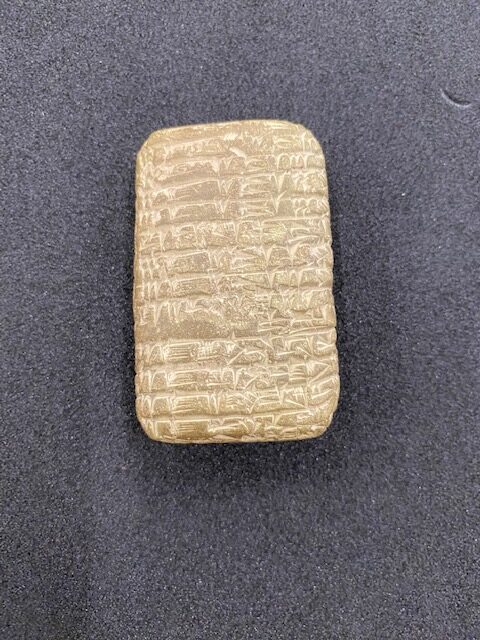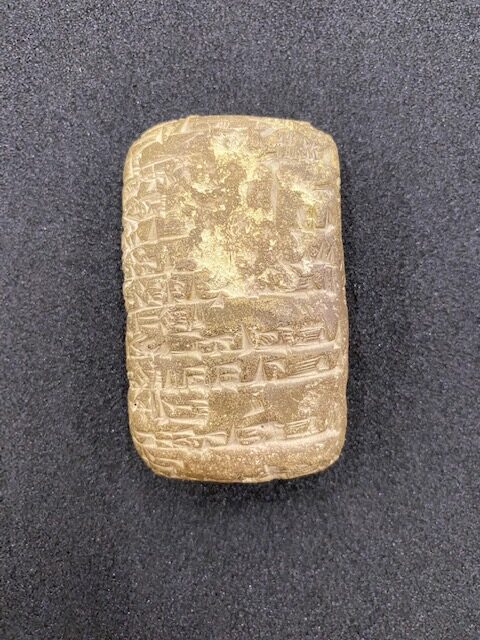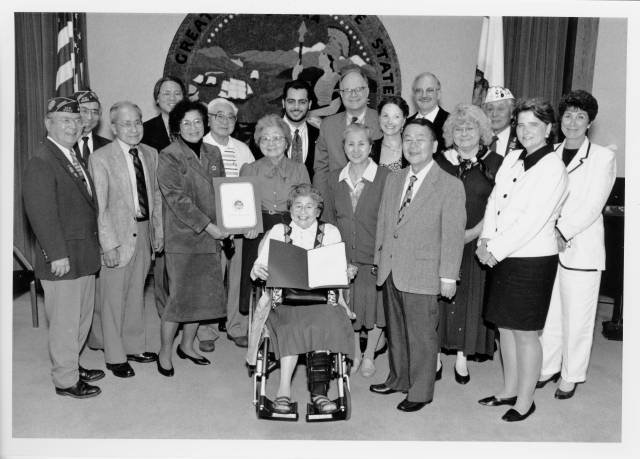If you’ve ever passed through the back entrance of the library complex, then you’ve likely noticed the Sacramento State Archives. There you’ll find all sorts of fascinating documents and artifacts, from old mascot uniforms to first edition books. One item in particular that’ll most likely catch your attention is a 5,000-year-old cuneiform tablet that the archives keeps in a secure room near the center of the building.
For those unfamiliar, cuneiform was a writing system developed around 6,000 years ago in what is now southern Iraq and was made by impressing small, wedge-shaped marks on wet clay. This writing system was used to transcribe many different languages at the time and is largely regarded as the first writing system to ever be invented.2
This tablet is believed to have been created by the Sumerians in the city of Umma around 3,000 B.C.E. and is extremely well preserved considering its age.3 Only about 3.5 inches tall and 2 inches wide, the wedge-like marks covering the tablet are still quite visible except for one side where the surface seems to have been chipped.


Thanks to the work of a Professor Friedman from UC Davis back in 1980, we have a near-complete translation of the tablet. From what the professor was able to translate we know that the tablet was used to keep inventory of agricultural items (specifically “reeds”).4 This was most likely used as a record for taxation or trade purposes.
Though Professor Friedman was instrumental in the translation of the text, who they were exactly is something of a mystery. History professor at Sac State, Dr. Marwa Helmy, attempted to track down the identity of this professor by reaching out to faculty members at UC Davis and UC Berkeley but unfortunately had no luck.5 I also attempted to track down this professor by looking through Davis’ faculty lists, but found no professors, past or present, that fit the background of someone knowledgeable in the ancient Akkadian dialect written on the tablet.
In addition to whoever this translator was, there’s also the mystery surrounding how this tablet made its way to the archives in the first place. According to the former Head of Special Collections, Sheila O’Neill, the most likely explanation is that it was donated by Eugene Salmon, former Head Humanities Reference Librarian at the Sac State Library, back in 1993. She went on to explain that Salmon taught a class back in the 1960s and 70s called History of the Book, and that he frequently bought and collected items to use as teaching aids for this class. The items included papyrus texts, English literature, and possibly the cuneiform tablet in question.6
Though it’s likely the tablet originated from Salmon’s donation, it’s anything but certain. The finding aid associated with the donation mentions that “Tablets” were among the items given to the archives.7 However, it’s not clear if it’s referring to the cuneiform or something else entirely.
Regardless of how the tablet got to Sac State, its inclusion in special collections gives students an important first-hand account of the beginnings of written language.
Notes
1Courage the Cowardly Dog, season 2, episode 7, “King Ramses’ Curse/The Clutching Foot,” directed by John R. Dilworth, aired January 21, 2000, on Cartoon Network.
2Anne Trubeck, “What the Heck is Cuneiform Anyway?” Smithsonian Magazine, October 20, 2015, https://www.smithsonianmag.com/history/what-heck-cuneiform-anyway-180956999/.
3Friedman, Cuneiform Translation, May 14, 1980.
4Friedman, Translation.
5Marwa Helmy, email message to Eric Donley, April 1, 2023.
6Sheilla O’Neill, telephone interview by Eric Donley, April 4, 2023.
7Christopher Rockwell, Guide to the Eugene N. Salmon papers, 1940-1985 (1950-1980), California State University, Sacramento Collections & University Archives, 2006, https://oac.cdlib.org/findaid/ark:/13030/kt8b69r8d7/entire_text/.
Bibliography
Courage the Cowardly Dog. 2000. Season 1, episode 7, “King Ramses’ Curse/The Clutching Foot.” Directed by John R. Dilworth. Aired January 21, 2000, on Cartoon Network.
Friedman. Cuneiform tablet translation. May 14, 1980.
Helmy, Marwa. Email message to Eric Donley. April 1, 2023.
O’Neill, Sheila. Telephone interview by Eric Donley. April 4, 2023.
Rockwell, Christopher. Guide to the Eugene N. Salmon papers, 1940-1985 (1950-1980). California State University, Sacramento Special Collections & University Archives, 2006. http://Rockwell, Christopher. Guide to the Eugene N. Salmon papers, 1940-1985 (1950-1980). California State University, Sacramento Special Collections & University Archives, 2006.
Trubeck, Anne. “What the Heck is Cuneiform, Anyway?” Smithsonian Magazine, October 20, 2015. https://www.smithsonianmag.com/history/what-heck-cuneiform-anyway-180956999/.



Great work! I enjoyed reading this, I have actually seen this slab but never thought much of it. I found it fascinating how Dr. Marwa Helmy could not find Professor Friedman. It seems like a big mystery. I am also curious now about how many things Sac State has that are this old. I never knew this slab was that old. After reading this I might start walking more around campus and keeping a closer eye on everything.